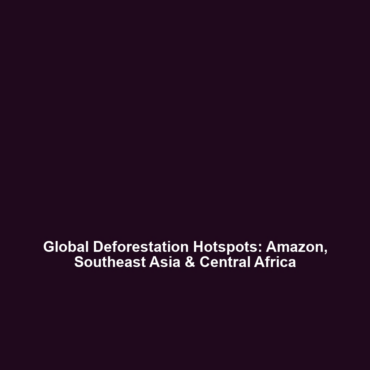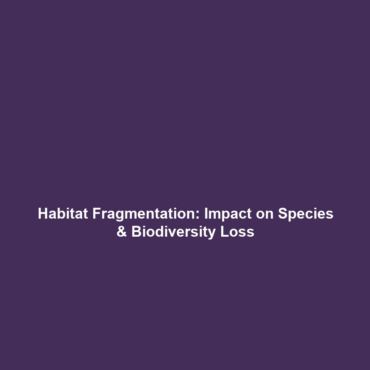Global Hotspots of Deforestation: Amazon Rainforest, Southeast Asia, and Central Africa
Introduction
Deforestation and biodiversity loss are pressing environmental issues that threaten the planet’s ecological balance. The Amazon Rainforest, Southeast Asia, and Central Africa are identified as global hotspots of deforestation, representing critical regions where extensive tree loss significantly impacts biodiversity. Understanding these areas is essential for conservation efforts and sustainable management practices to protect not only the forests themselves but also the myriad species that inhabit them. By exploring these hotspots, we can begin to address the vital connections between deforestation and biodiversity loss.
Key Concepts
Understanding Deforestation
Deforestation involves the permanent removal of tree cover, typically to facilitate agriculture, urban development, or resource extraction. This phenomenon contributes directly to biodiversity loss, as ecosystems that support diverse life forms are degraded.
Hotspots of Deforestation
Several regions have emerged as critical areas for conservation due to their high rates of deforestation:
- Amazon Rainforest: Known as the “lungs of the Earth,” this rainforest is undergoing rampant deforestation primarily for cattle ranching and soy production.
- Southeast Asia: This region faces severe losses due to palm oil plantations, logging, and agriculture, significantly impacting species such as orangutans and tigers.
- Central Africa: High rates of logging and agricultural expansion threaten valuable forests while endangering native wildlife, including gorillas and elephants.
Applications and Real-World Uses
Understanding the dynamics of deforestation hotspots helps inform policies and conservation strategies aimed at mitigating biodiversity loss:
- Conservation Initiatives: Targeted projects aimed at reforestation and sustainable land use in these hotspots.
- Policy Development: Creating regulations that protect threatened species and their habitats.
- Agricultural Practices: Implementing sustainable farming techniques that minimize environmental impacts, particularly in Southeast Asia’s palm oil industry.
Current Challenges
The study of global hotspots of deforestation presents several challenges:
- Lack of comprehensive data on forest change and biodiversity impacts.
- Political and economic obstacles that hinder effective policy implementation.
- Resistance from industries reliant on deforestation for economic gain.
- Challenges in engaging local communities in conservation efforts.
Future Research and Innovations
Innovations and future research play a pivotal role in addressing deforestation and biodiversity loss:
- Remote Sensing Technology: Advances in satellite imaging allow for more accurate tracking of deforestation rates.
- Ecological Modeling: New models can predict the impacts of land-use changes on biodiversity, aiding in better planning.
- Community-Led Conservation: Research supporting grassroots initiatives to empower local populations in sustainable practices.
Conclusion
Global hotspots of deforestation, specifically the Amazon Rainforest, Southeast Asia, and Central Africa, represent critical areas for conservation efforts due to their significant contributions to biodiversity loss. Protecting these regions is essential for maintaining ecological balance and ensuring the survival of countless species. We encourage readers to engage with local and international conservation organizations to advocate for sustainable practices that benefit both the environment and humanity. For more information on related topics, check out our articles on sustainable practices in forestry and the importance of biodiversity conservation.

